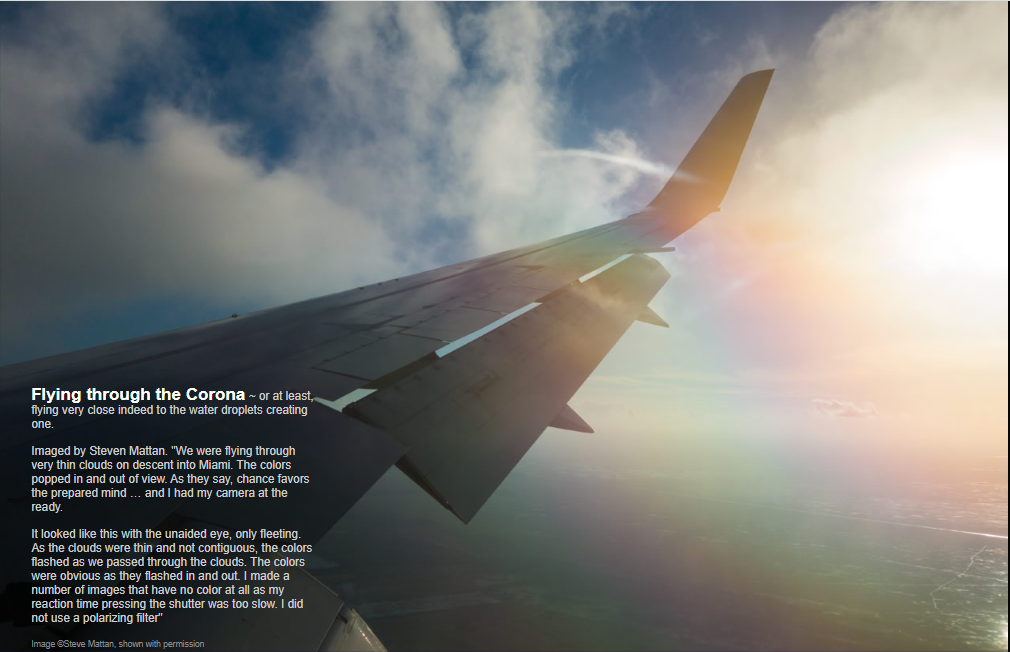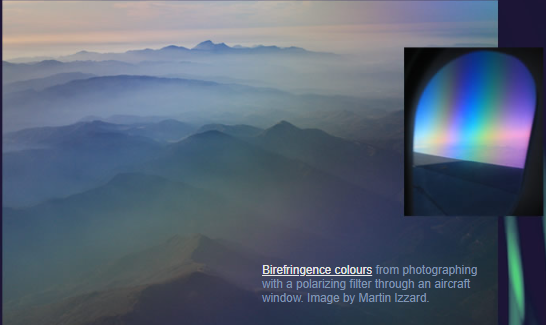Corona versus aircraft window colours - OPOD
Corona versus Aircraft Window Colours: Exploring Optical Phenomena in the Sky
Have you ever noticed vibrant colors flashing in and out of view while flying through thin clouds? These stunning displays, known as coronas, are created by the diffraction of sunlight by individual water droplets. While experiencing this phenomenon firsthand is captivating, capturing it on camera can be equally mesmerizing.
Photographer Steven Mattan had the opportunity to document the beauty of a corona while descending into Miami. The colors he witnessed appeared fleetingly as the aircraft passed through the thin, non-contiguous clouds. The colors were so striking that he quickly grabbed his camera and snapped several images. However, due to the rapid nature of the phenomenon, some of his shots failed to capture the vibrant hues. It's worth noting that Mattan did not use a polarizing filter, which can sometimes alter the colors observed.
Birefringence is another optical effect that can produce false colors when photographing through aircraft windows. This phenomenon occurs due to the varying refractive indices of the window layers. To determine if the colors seen in photographs are genuine, it is crucial to check if they are visible to the naked eye and if they change when the eye moves relative to the window. Additionally, observing whether the colors disappear sharply when passing through clouds or near metal parts of the aircraft can provide further insights. Since clouds and metal surfaces do not polarize light on reflection, they do not produce colors through birefringence.
To gain a better understanding of the corona phenomenon, it's essential to examine how the colors align relative to the sun. In a photograph captured by Martin Izzard, the aircraft was passing through intermittent thin clouds, creating ideal conditions for corona or iridescence production. The image reveals numerous rings, indicating the presence of very small and uniform water droplets, likely freshly formed.
The corona itself is produced by the diffraction of sunlight as it interacts with individual water droplets. When sunlight encounters a droplet, waves scattered primarily from the droplet's periphery combine and interfere, resulting in the distinctive ringed pattern observed in coronas. This optical effect is similar to the phenomenon of iridescence, where light is diffracted by small particles or structures, such as water droplets or ice crystals, producing a shimmering array of colors.
Understanding these atmospheric optics phenomena can enhance our appreciation for the natural wonders that surround us during air travel. Whether it's the ephemeral beauty of a corona or the captivating colors created by birefringence, observing and documenting these optical effects can provide a unique perspective on the interaction between light and the atmosphere.
Next time you find yourself on a flight, keep an eye out for these awe-inspiring displays. And if you're lucky enough to witness a corona or experience the vivid colors produced by birefringence, don't forget to have your camera ready to capture the magic. Remember, chance favors the prepared mind, and in this case, it may just reward you with a breathtaking image that showcases the wonders of atmospheric optics.
Note: This article has been automatically converted from the old site and may not appear as intended. You can find the original article here.

Flying through the Corona ~ or at least, flying very close indeed to the water droplets creating one.
Imaged by Steven Mattan. "We were flying through very thin clouds on descent into Miami. The colors popped in and out of view. As they say, chance favors the prepared mind … and I had my camera at the ready.
It looked like this with the unaided eye, only fleeting. As the clouds were thin and not contiguous, the colors flashed as we passed through the clouds. The colors were obvious as they flashed in and out. I made a number of images that have no color at all as my reaction time pressing the shutter was too slow. I did not use a polarizing filter"
Image ©Steve Mattan, shown with permission

Birefringence colours from photographing with a polarizing filter through an aircraft window. Image by Martin Izzard.
Colours across photographs taken through aircraft windows can have false colours produced by birefringence in the window layers.
As with any optical effect appearing in a camera, check whether the colours are visible by eye and whether they move about or change when the eye is moved relative to the window.
Other tests are whether the colours disappear sharply where there are clouds or metal parts of the aircraft. These do not polarise light on reflection and do not therefore produce colours.
Check also how the colours are aligned relative to the sun.
In the above image the craft was passing through intermittent thin cloud, ideal for corona or iridescence production by diffraction of sunlight. The many rings and their broad extent speak of very small and uniform (probably freshly formed) water droplets.

The corona is produced by diffraction of sunlight by individual water droplets. Waves scattered by the droplet - primarily from its periphery - combine and interfere to produce the ringed pattern.
Note: this article has been automatically converted from the old site and may not appear as intended. You can find the original article here.
Reference Atmospheric Optics
If you use any of the definitions, information, or data presented on Atmospheric Optics, please copy the link or reference below to properly credit us as the reference source. Thank you!
-
<a href="https://atoptics.co.uk/blog/corona-versus-aircraft-window-colours-opod/">Corona versus aircraft window colours - OPOD</a>
-
"Corona versus aircraft window colours - OPOD". Atmospheric Optics. Accessed on December 28, 2024. https://atoptics.co.uk/blog/corona-versus-aircraft-window-colours-opod/.
-
"Corona versus aircraft window colours - OPOD". Atmospheric Optics, https://atoptics.co.uk/blog/corona-versus-aircraft-window-colours-opod/. Accessed 28 December, 2024
-
Corona versus aircraft window colours - OPOD. Atmospheric Optics. Retrieved from https://atoptics.co.uk/blog/corona-versus-aircraft-window-colours-opod/.